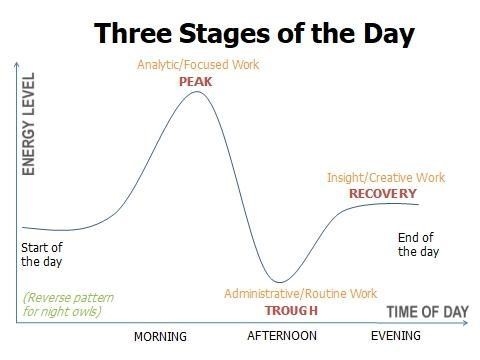This article introduces 3 steps that will enhance your daily productivity. We first learn about the productivity cycle during the day, the concept of chronotype and its relationship to the productivity cycle, how to discover your chronotype, how to redistribute your daily tasks more effectively to accomplish the right task at the most appropriate time, and how to keep your productivity at peak level today, using the Pomodoro Technique.
Personal Productivity Cycle:
The three stages of daily productivity:

Illustration 1: The three stages of daily productivity
If we want to improve our focus and productivity, we need to make sure that the circadian rhythm is working correctly, as sleep doctors and psychologists confirm. They found that personal productivity goes through three stages (illustrated in Illustration 1) during the day:
- Peak / climax.
- Trough/bottom.
- Recovery.
Several studies found that in the hours before and at our peak, we are more focused and less easily distracted, as we think more clearly, which makes it an ideal time for analytical tasks.
Studies also found that the trough does not mean a complete loss of our productivity. In fact, it is the best time for simple routine and administrative tasks, while the recovery phase is ideal for creative tasks, as creativity thrives when we’re easily distracted. This is because distractions actually help us make connections to the creative side of the brain that we don’t often make if we’re really focused.
This means that you can stay productive throughout the day if you schedule your time to complete the right tasks during the right part of the day as follows:
- Before and during Peak stage, work on the analytical tasks.
- During the Trough stage, work on routine tasks.
- In the Recovery stage, work on creative tasks.
Let’s take the task of writing the article as an illustrative example. When you analyze this task, you will find that it consists of 4 main steps:
1. Brainstorming writing ideas:
Which is the most creative task, in which you are excited to write an article about these ideas and not embarrassed to send it to the editor.
2. Research:
This task requires a lot of focus and analysis in searching for sources for your ideas, whether by reviewing books or different websites.
3. Writing the outline:
Creating an outline for an article is a creative task, in which you define exactly what you want to write about, and in what order it makes sense to present this information.
4. Writing the article:
While many believe that writing is a creative task in the case of poetry or novel and story writing, article writing requires maintaining focus and analysis in writing words according to the outline that will convey information to the reader.
Then all you have to do to implement the task of writing an article is to redistribute its steps in a way that matches the daily productivity cycle to ensure that you do the task with the highest efficiency and effectiveness as follows:
- Do the parts that require focus and analysis at or before your peak productivity stage (research and writing task).
- Do the parts that require creativity in the recovery stage (the task of brainstorming and writing an outline).
“Timing is everything” is a very accurate phrase and a clear indication that doing the right kind of tasks at the right time of the day is key to reaching peak performance. In order to know the right time for you to do these various tasks, you have to discover your unique chronotype.
First, discover your personal chronotype:
A chronotype is a classification system used to help understand sleep and productivity schedules, including the times of the day when you are most active and alert, and when you are most creative.
In his book “When: The Scientific Secrets of Perfect Timing”, Daniel H. Pink, an American writer, developed a personal chronotype model to classify people into three categories. His review of research papers in psychology, biology, and economics on the subject has demonstrated that there are times when we are less distracted and more analytical, and in turn, there are times when we are more able to come up with creative ideas, reflection, and insight.
In his book, Pink uses the three most common chronotype categories, which are the owl to describe the late night preferences, the morning bird to describe the early morning preferences, and for the categories in between, he uses the third bird category to describe the late morning preferences. In the table below, we have summarized the appropriate times for each of Pink's chronotypes and the tasks associated with the productivity cycle as follows:
|
Pink’s Model |
Lark |
Third Bird |
Owl |
|
|
Morning-evening chronotype |
Definite morning |
Moderate evening to moderate morning |
Definite evening |
|
|
Productivity cycle stages |
Main tasks |
|
|
|
|
Peak (Ideal energy, high alertness, best mood) |
Analytic tasks |
Early morning |
Early morning to mid-morning |
Late afternoon and evening |
|
Trough (Sharp fall in mood, energy, and alertness) |
Administrative tasks |
Early afternoon to mid-afternoon |
Early afternoon to mid-afternoon |
Early afternoon to mid-afternoon |
|
Recovery (Sharp rise in energy and mood but not in alertness) |
Creative tasks |
Late afternoon/ early morning |
Late afternoon/ early morning |
Morning |
** Pink used the five original groups in the morning-evening model for chronotypes, but he summarized them into 3 categories instead.
To find out under which of the three categories your chronotype falls, you can fill out the Personal Chronotype Questionnaire via this link (AutoMEQ).
In his book, Pink encourages you to keep track of your daily activities to know exactly your peak, trough, and recovery hours over the course of at least two weeks or a month. This process reveals to you many things about what you do daily, including the priority with which you deal with daily tasks (the Eisenhower Priority Matrix), the types of these tasks, as well as the amount of mental alertness you experience during the performance of the task at hand, and how energetic you feel while performing it.
Through this link, we offer you a daily activity tracking schedule to facilitate this task for you. You can also customize it to suit you personally.
Second, prioritize your most important tasks:
The purpose of distributing your tasks in a weekly or daily schedule is to take advantage of your peak hours and reserve them for analytical tasks that require high concentration and clarity of mind. You also have to reserve recovery periods for tasks that require creative thinking. Setting priorities during your daily or weekly plan will guarantee this.
This includes making an appointment with yourself to do one cognitively demanding task, such as:
- Writing a legal summary.
- Replying to messages from clients.
- Dealing with questions from your direct manager.
- Internal meetings.
- Individual reflection session.
Or a group of similar tasks that require low cognitive effort, such as:
- Replying to email inquiries.
- Answering routine phone calls.
- Walking with a colleague to discuss a business issue.
- Listening to a video tutorial.
- Updating your notes, in a specified period of time.
It is not always necessary to deal with the highest priority tasks in the morning or at the beginning of the work day. However, just make sure that you determine the appropriate time to take care of it, and make sure that the task matches your energy level, personal circumstances, and your external environment.
For example, do your most important tasks when your clarity of mind and alertness are at their peak, you have the fewest interruptions, and you have access to a quiet workspace. Also, you can at least choose the background noise, and in turn, do your administrative or routine tasks when your energy is low, you are more prone to distraction, and your workspace is noisier and more cluttered.
Third, schedule your work and take real breaks:
These breaks may be solitary, such as meditating or reading a soothing book, social, like chatting with a colleague about the upcoming weekend, or having lunch with them. Remember that getting out of the office is better than staying indoors – if at all possible – and movement such as walking, stretching, and going to the gym should be a constant and important part of these breaks, especially if you work in your office for long hours.
The Pomodoro Technique is a way to focus on a task for a specified period of time and take the necessary rest breaks. It is based on the fact that our bodies have a regular rhythm, a wake-rest-activity cycle that repeats throughout twenty-four hours a day. This cycle includes alternating periods of high-frequency brain activity for about 90 minutes, followed by low-frequency brain activity about 20 minutes. Experts advise taking advantage of this cycle and taking a break of 20 minutes for every 90 minutes of work to benefit from the ultradian mental rhythm cycle.
You can apply this technique through the following steps:
One Pomodoro cycle:
- Select the task to be done.
- Set the timer for twenty-five minutes.
- Do the task until the timer rings for twenty-five minutes.
- Take a 5 minute break.
- Repeat steps 1-4 four times, and after two hours have passed, take a 20-minute long break.
In conclusion:
What the writer “Daniel Pink” advises in his book is that you first discover and understand your chronotype by reading his book “When: The Scientific Secrets of Perfect Timing”, then classify and analyze the tasks you are working on into routine tasks or tasks that require cognitive effort, focus, or creativity, and then distribute these tasks to the most appropriate periods of your day, based on your chronotype. To keep the daily stages of focus and creativity for as long as possible, use time management tools like the priority matrix and the Pomodoro technique.



Add comment